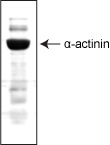Alpha-actinin protein: rabbit skeletal muscle
Product Uses Include
- Discover and characterize α-actinin binding proteins
- Positive control of actin binding assays
- Positive control for actin bundling assays
Material
α-actinin has been purified from rabbit skeletal muscle. The protein is supplied as a lyophilized powder and upon reconstitution, will be in the following buffer: 4 mM Tris-HCl pH 7.6, 4 mM NaCl, 20 μM EDTA, 1% (w/v) sucrose, and 0.2% (w/v) dextran. The lyophilized product is stable at -70°C for at least 2 years. AT01 should be resuspended in nanopure water containing 1 mM β-mercaptoethanol or DTT to the desired working concentration.
Purity
Purity is determined by scanning densitometry of the protein on an SDS-PAGE gel. α-actinin is >90% pure.

Figure 1: α-actinin protein purity determination. 20 µg of AT01 was run on an SDS-PAGE gel and stained with coomassie blue.
Biological Activity
At 2.5 µM (0.25 mg/ml) α-actinin and 25 µM (1.0 mg/ml) F-actin at pH 7.0 and 24°C, approximately 70% of the α-actinin will co-sediment with F-actin after centrifugation at 150,000 x g for 1 h.
For product Datasheets and MSDSs please click on the PDF links below. For additional information, click on the FAQs tab above or contact our Technical Support department at tservice@cytoskeleton.com
Question 1: What is the source of the alpha-actinin Cytoskeleton sells?
Answer 1: Cytoskeleton’s alpha-actinin (Cat. # AT01) is purified from rabbit skeletal muscle and has a purity of >85%.
Question 2: Can this alpha-actinin be used for actin bundling experiments?
Answer 2: Yes, Cytoskeleton’s alpha-actinin (Cat. # AT01) is well-suited for actin bundling experiments using skeletal muscle actin, it will not work with non-muscle isoforms of actin. Briefly, α-actinin is tested for biological activity by a co-sedimentation assay with Factin. At 2.5 μM skeletal muscle α-actinin and 25 μM actin in the form of F-actin, >70% α-actinin will co-sediment with F-actin. The reaction is carried out at pH 7.0 for 30 minutes at 24°C (at pH 8.0 α-actinin will not bind). Spin the mixture at 14,000 x g for 10 minutes. Probe a western blot with antibodies against alpha-actinin and actin. An SDS-PAGE gel is loaded with supernatant and pellet samples from alpha-actinin + actin and actin alone. After running the gel to separate samples it is stained with coomassie blue and then analyzed for band intensity at 43 and 116 kDal.
If you have any questions concerning this product, please contact our Technical Service department at tservice@cytoskeleton.com









